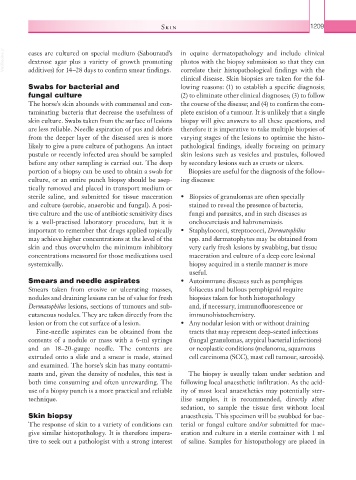Page 1234 - Equine Clinical Medicine, Surgery and Reproduction, 2nd Edition
P. 1234
Skin 1209
VetBooks.ir cases are cultured on special medium (Sabouraud’s in equine dermatopathology and include clinical
photos with the biopsy submission so that they can
dextrose agar plus a variety of growth promoting
additives) for 14–28 days to confirm smear findings.
correlate their histopathological findings with the
clinical disease. Skin biopsies are taken for the fol-
Swabs for bacterial and lowing reasons: (1) to establish a specific diagnosis;
fungal culture (2) to eliminate other clinical diagnoses; (3) to follow
The horse’s skin abounds with commensal and con- the course of the disease; and (4) to confirm the com-
taminating bacteria that decrease the usefulness of plete excision of a tumour. It is unlikely that a single
skin culture. Swabs taken from the surface of lesions biopsy will give answers to all these questions, and
are less reliable. Needle aspiration of pus and debris therefore it is imperative to take multiple biopsies of
from the deeper layer of the diseased area is more varying stages of the lesions to optimise the histo-
likely to give a pure culture of pathogens. An intact pathological findings, ideally focusing on primary
pustule or recently infected area should be sampled skin lesions such as vesicles and pustules, followed
before any other sampling is carried out. The deep by secondary lesions such as crusts or ulcers.
portion of a biopsy can be used to obtain a swab for Biopsies are useful for the diagnosis of the follow-
culture, or an entire punch biopsy should be asep- ing diseases:
tically removed and placed in transport medium or
sterile saline, and submitted for tissue maceration • Biopsies of granulomas are often specially
and culture (aerobic, anaerobic and fungal). A posi- stained to reveal the presence of bacteria,
tive culture and the use of antibiotic sensitivity discs fungi and parasites, and in such diseases as
is a well-practised laboratory procedure, but it is onchocerciasis and habronemiasis.
important to remember that drugs applied topically • Staphylococci, streptococci, Dermatophilus
may achieve higher concentrations at the level of the spp. and dermatophytes may be obtained from
skin and thus overwhelm the minimum inhibitory very early fresh lesions by swabbing, but tissue
concentrations measured for those medications used maceration and culture of a deep core lesional
systemically. biopsy acquired in a sterile manner is more
useful.
Smears and needle aspirates • Autoimmune diseases such as pemphigus
Smears taken from erosive or ulcerating masses, foliaceus and bullous pemphigoid require
nodules and draining lesions can be of value for fresh biopsies taken for both histopathology
Dermatophilus lesions, sections of tumours and sub- and, if necessary, immunofluorescence or
cutaneous nodules. They are taken directly from the immunohistochemistry.
lesion or from the cut surface of a lesion. • Any nodular lesion with or without draining
Fine-needle aspirates can be obtained from the tracts that may represent deep-seated infections
contents of a nodule or mass with a 6-ml syringe (fungal granulomas, atypical bacterial infections)
and an 18–20-gauge needle. The contents are or neoplastic conditions (melanoma, squamous
extruded onto a slide and a smear is made, stained cell carcinoma (SCC), mast cell tumour, sarcoids).
and examined. The horse’s skin has many contami-
nants and, given the density of nodules, this test is The biopsy is usually taken under sedation and
both time consuming and often unrewarding. The following local anaesthetic infiltration. As the acid-
use of a biopsy punch is a more practical and reliable ity of most local anaesthetics may potentially ster-
technique. ilise samples, it is recommended, directly after
sedation, to sample the tissue first without local
Skin biopsy anaesthesia. This specimen will be swabbed for bac-
The response of skin to a variety of conditions can terial or fungal culture and/or submitted for mac-
give similar histopathology. It is therefore impera- eration and culture in a sterile container with 1 ml
tive to seek out a pathologist with a strong interest of saline. Samples for histopathology are placed in

